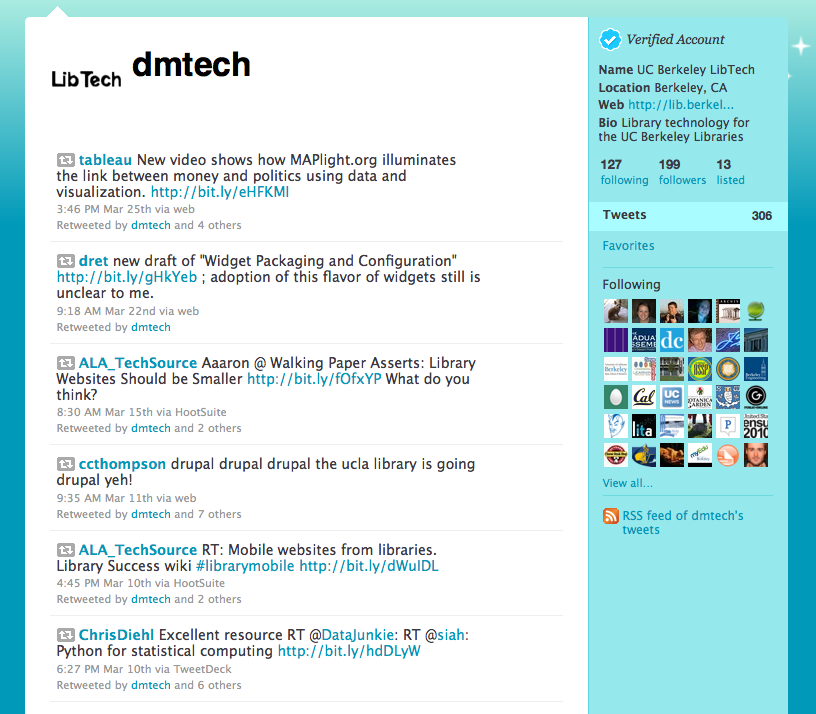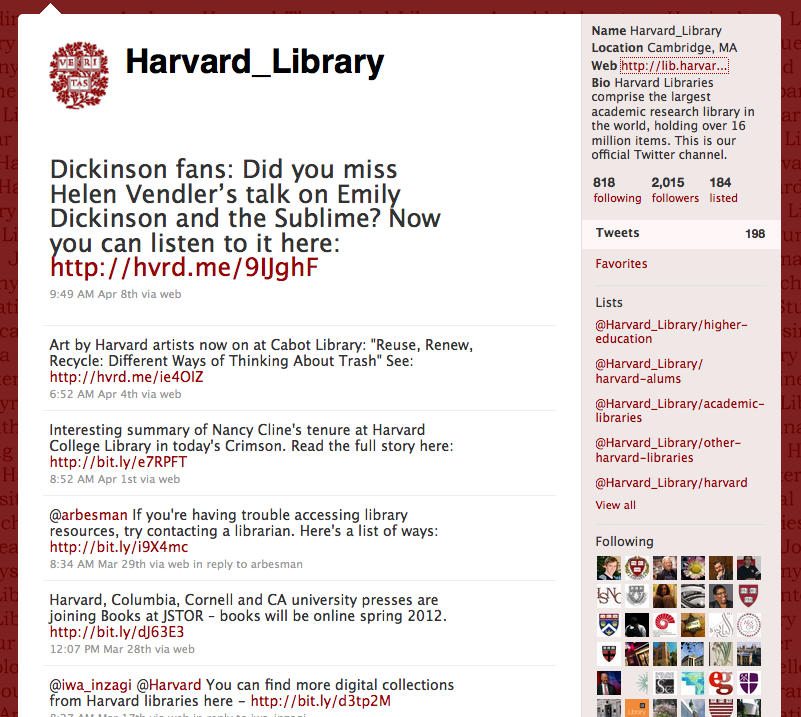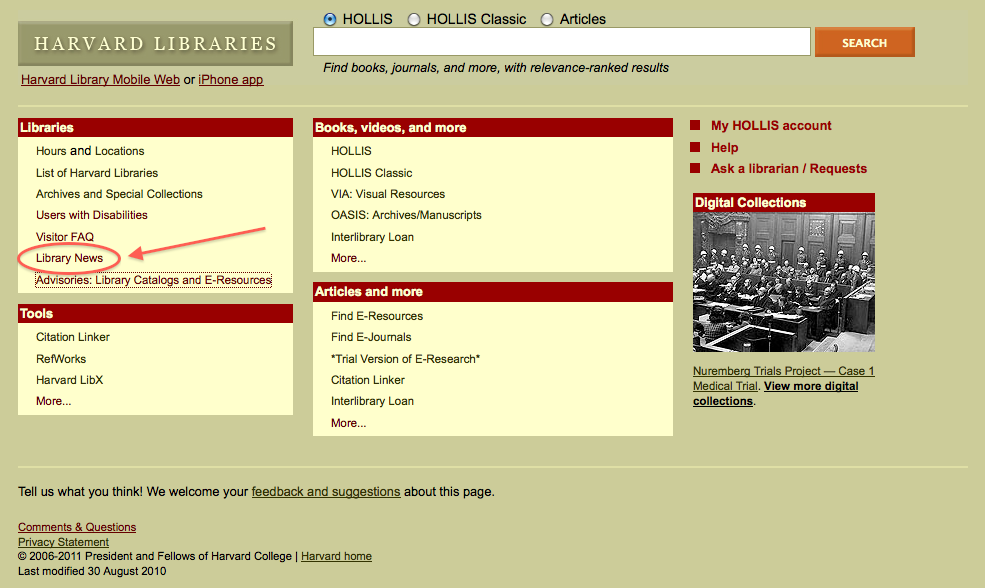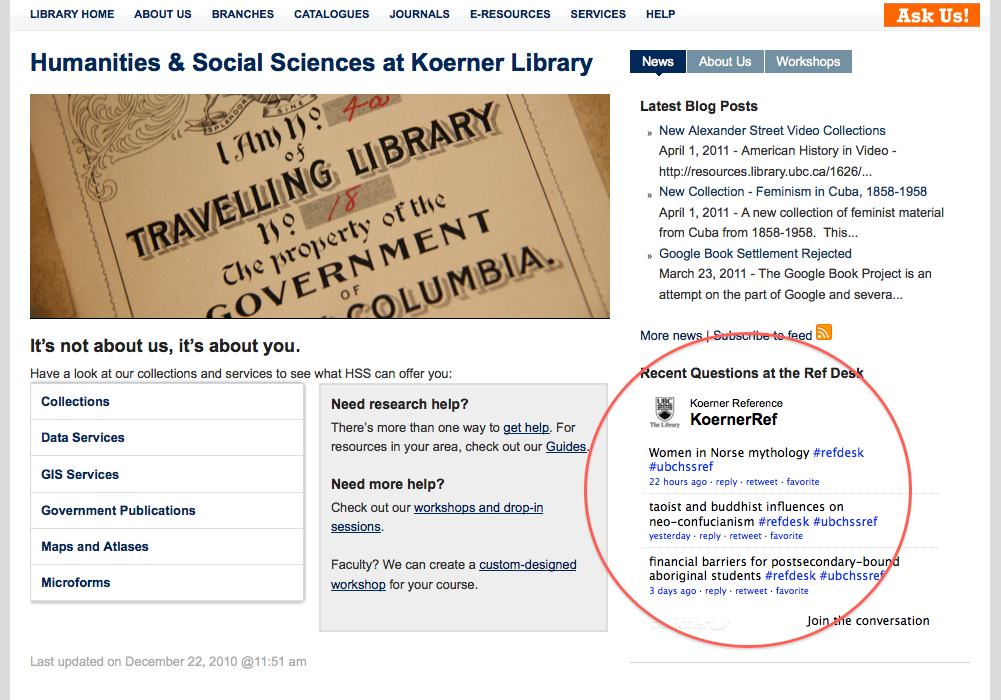Twitter seems to be the brand name that has become commonplace for micro-blogging in general. Now, I’ll admit that I’ve had difficulty assessing Twitter’s overall value as a technology. With a restriction to 140 characters, the technology really seems much more useful for mobile devices with data packages, for information quickies on the go, rather than an in-depth representation of services. All that being said, Phil Bradley offers some worthwhile uses of Twitter for libraries:
- General Information Updates
- Staff Information
- New Resources
- General Information
- Countdowns for Library Events
- Links to Images About the Library
- News Alert Service
- Notify Patrons About What the Library is Doing
- Conversations About the Library or Subject Area of Interest
- Awareness for Specific Subjects or Specific Groups of People
- Update News RSS Feed on Library Webpage
- Share Best Practices with Other Libraries
…and some instances when using Twitter misses the mark:
- Tweeting without following anyone
- Tweets aren’t open to the general public (i.e. you can’t see their Tweets until you commit to following them)
- If you don’t see a value in it, don’t use it, and come back later to try it again
All right, but what about the academic context? How are university libraries implementing micro-blogging? Let’s take a look at three university library Twitter accounts to get a sense of how they’re using the technology: UC Berkeley Library Technology Training, Harvard Library, and Koerner Library at University of British Columbia.
The first notable comparison is that not all three websites offer links to their corresponding Twitter accounts, but all of the Twitter accounts link to relevant pages for further information. Here are the screenshots of each Twitter account, with a corresponding screenshot of their homepage:
Some of the UC Berkeley Libraries are utilizing Twitter, some examples include the Bancroft Library, or the Institute for Research on Labor and Employment Library. However, the UC Berkeley Libraries, the main Doe Library at UC Berkeley, and the undergraduate Moffitt Library at UC Berkeley, only have corresponding Facebook accounts. Instead, there is a Twitter account for Doe and Moffitt Library technology training (i.e. dmtech) as a resource for colleagues to remain up to speed on latest technologies. The About page states that the goal of the sessions “is to provide an environment for staff to learn technologies that have practical applications and would help them in their day-to-day jobs.” The fact that there are no links readily available to the Twitter account from the main UC Berkeley Library page, as well as the UC Berkeley Library Technology Training page, that the followers only amount to around two hundred, and that many of the Tweets are Re-Tweets, does indicate the intended purpose of the account is a communication tool between library professionals.
The Harvard Library Twitter account, however, seems to have more of a general patron audience in mind. The Tweets are all very clearly related to Harvard Library events, resources, and news with little to no information Re-Tweets, and the account has well over 2,000 followers. Additionally, the Library News link from the Harvard Library homepage is a direct link to the Twitter account feed, and interesting media choice for broadcasting library related news, rather than utilizing RSS feeds.
The Koerner Library Humanities and Social Science Library at UBC offers an interesting comparison. Despite the rather small following, the library very clearly represents their Twitter feed on the main page, with a very clear articulation of purpose: we’re here to answer your questions and here of some of the kinds of questions we get. The research help information in the background of the Twitter account can be quite helpful for students who are seeking research help; however, it might also be a good idea to include a disclaimer about Tweeting reference questions, or to possibly expand the use of the Twitter account to include news about Koerner Library in general. UBC students might not be as interested in following only random reference questions, unless they believe that it will help them with their own research or studies. For example, it might help to include one link to the relevant subject research guide or one link to a good resource with each question.
Between the three Twitter feeds, I would be more inclined to use the dmtech feed as a library professional, the Harvard_Library feed as a formal library news/update resource, and KoernerRef for general intellectual enrichment. The Doe and Moffitt Libraries at UC Berkeley could potentially benefit from a Twitter account aimed at library patrons, to promote library resources, and library events. The Harvard Library might want to consider an overall better integration of social media services, including the use of RSS feeds and an announcement page for library related news and services. Lastly, KoernerRef could expand their Twitter feed to include links to library resources, as well as include library related news and announcements. Out of the three Twitter feeds, the Koerner Library’s Homepage is the best example of a well integrated use of Twitter.
I can’t say whether or not I’ve been won over by Twitter. The medium does offer certain social networking and informative benefits. However, whenever I think about trying it out, I think about the Futurama episode “Attack of the Killer App”. The episode is basically a parody of all the hype that happens around the “EyePhone” and “Twitcher” applications. Yes, I know it’s pretty silly to base one’s trepidations on a popular cartoon comedy show, but the main moral of the episode was to think before jumping on the next new technology trend. I think that we can all agree about the importance of having clear, consistent, and strategic goals for implementing new technology tools in order to enhance library and information services.






Trackbacks